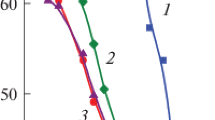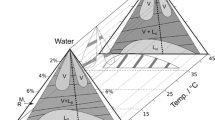Abstract
This work investigates decylammonium salts, with inorganic (chloride and thiocyanate) and organic (acetate and butyrate) counterions, in interaction with poly(methacrylic acid) (PMA). The study is conducted by means of surface tension, relative viscosity and pH measurements. The role of the methyl group in PMA appears by comparison with analogous mixtures of poly(acrylic acid) (PAA). In aqueous solution, a non-cooperative interaction between the surfactant and the hydrophobic microdomains (HMD) of PMA starts first. With surfactant addition, micellar aggregates bound onto the polymer chain appear at a concentration T 1, which is higher than for the analogous PAA systems, but lower than the respective CMC. T 1 is lower for chloride than for thiocyanate and lower for acetate than for butyrate. Depending on the counterion, the HMD conceal or expose carboxyl groups, with influence upon the interaction strength and the bulk and surface behavior. Stronger interactions and maxima of surface tension and relative viscosity appear for the systems with organic counterions. An estimation of the interaction strength shows weaker surfactant interactions with PMA than with PAA, and that acetate induces the strongest interaction while thiocyanate the weakest.







Similar content being viewed by others
Abbreviations
- CMC:
-
Critical micellar concentration
- Cp:
-
Polymer concentration
- DeA-Cl:
-
Decylammonium chloride
- DeA-SCN:
-
Decylammonium thiocyanate
- DeA-Ac:
-
Decylammonium acetate
- DeA-Bu:
-
Decylammonium butyrate
- HMD:
-
Hydrophobic microdomains
- PAA:
-
Poly(acrylic acid)
- PMA:
-
Poly(methacrylic acid)
- PS:
-
Polymer–surfactant
- SDS:
-
Sodium dodecylsulfate
- T 1 :
-
The concentration at which the surfactant micellar aggregation onto the polymer begins
- T2′:
-
The concentration at which free surfactant monomers reappear in the system
- T 2 :
-
The concentration at which free micelles appear and coexist with the complex
- \( \Updelta G_{\text{PS}}^{{^{0} }} \) :
-
The molar free energy of interaction (kcal/mol)
- R :
-
The gas constant (cal/(mol K))
- T :
-
Temperature (K)
References
Hayakawa K, Kwak JCT (1991) Interactions between polymers and cationic surfactants. In: Rubingh DN, Holland PM (eds) Cationic surfactants: physical chemistry. Marcel Dekker, New York, pp 189–248
Goddard ED (1993) Polymer-surfactant interaction. Part II: polymer and surfactant of opposite charge. In: Goddard ED, Ananthapadmanabhan KP (eds) Interactions of surfactants with polymers and proteins. CRC, Boca Raton, pp 171–201
Lindman B, Thalberg K (1993) Polymer-surfactant interactions—recent developments. In: Goddard ED, Ananthapadmanabhan KP (eds) Interactions of surfactants with polymers and proteins. CRC, Boca Raton, pp 203–276
Wei YC, Hudson SM (1995) The interaction between polyelectrolytes and surfactants of opposite charge. J Macromol Sci Rev Macromol Chem Phys C 35:15–45
Zana R (1998) Polyelectrolyte-surfactant interactions: polymer hydrophobicity, surfactant aggregation number, and microstructure of the systems. In: Kwak JCT (ed) Polymer-surfactant systems. Marcel Dekker, New York, pp 409–454
Langevin D (2009) Complexation of oppositely charged polyelectrolytes and surfactants in aqueous solutions. A review. Adv Colloid Interface Sci 147–148:170–177
Goddard ED (1993) Applications of polymer-surfactant systems. In: Goddard ED, Ananthapadmanabhan KP (eds) Interactions of surfactants with polymers and proteins. CRC, Boca Raton, pp 395–414
Goddard ED, Ananthapadmanabhan KP (1998) Applications of polymer-surfactant systems. In: Kwak JCT (ed) Polymer-surfactant systems. Marcel Dekker, New York, pp 21–64
Alvarez-Lorenzo C, Concheiro A (2003) Effects of surfactants on gel behavior: design implications for drug delivery systems. Am J Drug Deliv 1:77–101
Saito S, Yukawa M (1969) Interactions of polymers and cationic surfactants with thiocyanate as counterions. J Colloid Interface Sci 30:211–218
Saito S, Yukawa M (1969) Solubilization of poly(vinyl acetate) by dodecylammonium thiocyanate. Kolloid Z Z Polym 234:1015–1017
Saito S (1970) Precipitation of some nonionic polymers by octylammonium thiocyanate. J Polym Sci A1 8:263–271
Saito S, Kitamura K (1971) Counterion effect of tetraalkylammonium and long-chain alkylammonium salts in the interaction with nonionic polymers. J Colloid Interface Sci 35:346–353
Zhang J, Zheng Y, Yu P, He L, Wang H, Wang R (2010) Synthesis, characterization and surface-activity of a polyoxyethylene ether trimeric quaternary ammonium surfactant. J Surfact Deterg 13:155–158
Saito S, Taniguchi T, Kitamura K (1971) Interactions of anionic surfactants with nonionic polymers. Comparison of guanidinium, tetraalkylammonium, and alkali metal ions as counterions. J Colloid Interface Sci 37:154–164
Binana-Limbele W, Zana R (1987) Fluorescence probing of microdomains in aqueous solutions of polysoaps. 1. Use of pyrene to study the conformational state of polysoaps and their comicellization with cationic surfactants. Macromolecules 20:1331–1335
Anghel DF, Saito S, Iovescu A, Baran A, Stinga G, Neamtu C (2003) Counterion effect of cationic surfactants on the interaction with poly(acrylic acid). Progr Colloid Polym Sci 122:16–26
Anghel DF, Mihai DM, Stinga G, Iovescu A, Baran A, v Klitzing R (2007) A Study upon the interaction of dodecylpyridinium chloride with sodium dextran sulfate. Rev Roum Chim 52:781–787
Piculell L, Sjöström J, Lynch I (2003) Swelling isotherms of surfactant-responsive polymer gels. Progr Colloid Polym Sci 122:103–112
Ananthapadmanabhan KP (1993) Surfactant solutions: adsorption and aggregation properties. In: Goddard ED, Ananthapadmanabhan KP (eds) Interactions of surfactants with polymers and proteins. CRC, Boca Raton, pp 5–58
Al-Sagheer F, Hey MJ (2004) Hofmeister anion effects on aqueous solutions of poly(ethylene oxide) studied by attenuated total reflectance FT-IR spectroscopy. Colloids Surf A 245:99–103
Kunz W, Lo Nostro P, Ninham BW (2004) The present state of affairs with hofmeister effects. Curr Opin Colloid Interface Sci 9:1–18
Vlachy N, Jagoda-Cwiklik B, Vacha R, Touraud D, Jungwirth P, Kunz W (2009) Hofmeister series and specific interactions of charged headgroups with aqueous ions. Adv Colloid Interface Sci 146:42–47
Saito S (1969) Salt effect on polymer solutions. J Polym Sci A1 7:1789–1802
Gurau MC, Lim SC, Castellana ET, Albertorio F, Kataoka S, Cremer PS (2004) On the mechanism of the hofmeister effect. J Am Chem Soc 126:10522–10523
Chen X, Yang T, Kataoka S, Cremer PS (2007) Specific ion effects on interfacial water structure near macromolecules. J Am Chem Soc 129:12272–12279
Bonciocat N, Anghel DF, Saito S, Iovescu A, Baran A (2003) An electrochemical model for interpreting the counterion effect of cationic surfactants in interaction with charged polymers. I. Adsorption isotherm. Counterion effect upon the adsorption process. Rev Roum Chim 48:425–431
Bonciocat N, Anghel DF, Saito S, Iovescu A, Baran A (2003) An electrochemical model for interpreting the counterion effect of cationic surfactants in interaction with charged polymers. II. Method for determining the adsorption free energies of the cationic surfactant counterions. Rev Roum Chim 48:521–526
Anghel DF, Saito S, Baran A, Iovescu A, Cornitescu M (2007) The aggregation of nonionic surfactants in the presence of poly(methacrylic acid). Colloid Polym Sci 285:771–779
Chu DY, Thomas JK (1986) Effect of cationic surfactants on the conformational transition of poly(methacrylic acid). J Am Chem Soc 108:6270–6276
Kiefer J, Somasundaran P, Ananthapadmanabhan KP (1993) Interaction of tetradecyltrimethylammonium bromide with poly(acrylic acid) and poly(methacrylic acid). Effect of charge density. Langmuir 9:1187–1192
Saito S (1994) Properties of nonionic surfactant-polymethacrylic acid complexes: comparison with the polyacrylic acid complexes. J Colloid Interface Sci 165:505–511
Shimizu T (1994) Changes of pH and counterion activity during the binding process of cationic surfactants to carboxylic polyions. Colloids Surf A 84:239–248
Katsuura H, Kawamura H, Manabe M, Kawasaki H, Maeda H (2002) Binding of a surfactant counterion to low-charge-density poly(acrylic acid) and poly(methacrylic acid). Colloid Polym Sci 280:30–37
Vlachy N, Dolenc J, Jerman B, Kogej K (2006) Influence of stereoregularity of the polymer chain on interactions with surfactants: binding of cetylpyridinium chloride by isotactic and atactic poly(methacrylic acid). J Phys Chem B 110:9061–9071
Maloney C, Huber K (1994) Mixtures of polyacrylic acid and nonionic surfactants at the water/air interface. J Colloid Interface Sci 164:463–470
Goddard ED (2002) Polymer/surfactant interaction: interfacial aspects. J Colloid Interface Sci 256:228–235
Anghel DF, Saito S, Iovescu A, Baran A (1994) Some critical points in the interaction between homogeneous non-ionic surfactants and poly(acrylic acid). Colloids Surf A 90:89–94
Anghel DF, Winnik FM, Galatanu N (1999) Effect of surfactant head group length on the interactions between polyethylene glycol monononylphenyl ethers and poly(acrylic acid). Colloids Surf A 149:339–345
Lynch I, Sjöström J, Piculell L (2005) Hydrophobicity and counterion effects on the binding of ionic surfactants to uncharged polymeric hydrogels. J Phys Chem B 109:4252–4257
Xu B-c, Han F, Shui J-h, Zhou Y-w (2009) Synthesis and characterization of lauryl trimethyl ammonium surfactants with new counteranion types. J Surfact Deterg 12:351–354
Goddard ED, Leung PS (1992) Studies of gel formation, phase behavior and surface tension in mixtures of a hydrophobically modified cationic cellulose polymer and surfactant. Colloids Surf 65:211–219
Goddard ED (1993) Polymer-surfactant interaction. part ii: polymer and surfactant of opposite charge. In: Goddard ED, Ananthapadmanabhan KP (eds) Interactions of surfactants with polymers and proteins. CRC, Boca Raton, pp 174–176
Goddard ED (1993) Polymer-surfactant interaction. Part I: Uncharged water-soluble polymers and charged surfactant. In: Goddard ED, Ananthapadmanabhan KP (eds) Interactions of surfactants with polymers and proteins. CRC, Boca Raton Figure 1, p 126
Folmer BM, Kronberg B (2000) Effect of surfactant-polymer association on the stabilities of foams and thin films: sodium dodecyl sulfate and poly(vinyl pyrrolidone). Langmuir 16:5987–5992
Prasad M, Palep R, Moulik SP (2006) Interaction between sodium dodecyl sulfate (SDS) and polyvinylpyrrolidone (PVP) investigated with forward and reverse component addition protocols employing tensiometric, conductometric, microcalorimetric electrokinetic and DLS techniques. Colloid Polym Sci 284:871–878
Taylor DJF, Thomas RK, Penfold J (2007) Polymer/surfactant interactions at the air/water interface. Adv Colloid Interface Sci 132:69–110
Acknowledgments
We thank Dr. Hiroshi Maeda, Prof. Emeritus Kyushu University, for his useful suggestions.
Author information
Authors and Affiliations
Corresponding author
About this article
Cite this article
Anghel, D.F., Saito, S., Iovescu, A. et al. Counterion Effect of Cationic Surfactants Upon the Interaction with Poly(methacrylic acid). J Surfact Deterg 14, 91–101 (2011). https://doi.org/10.1007/s11743-010-1202-y
Received:
Accepted:
Published:
Issue Date:
DOI: https://doi.org/10.1007/s11743-010-1202-y




